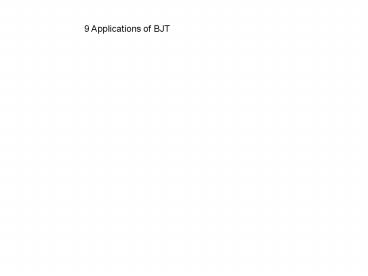9 Applications of BJT - PowerPoint PPT Presentation
1 / 21
Title:
9 Applications of BJT
Description:
In order to conserve space, work at lower beta than small-signal BJTs. ... wide E/narrow contact Xmas tree. efficient use of space && better than xmas tree ... – PowerPoint PPT presentation
Number of Views:2744
Avg rating:3.0/5.0
Title: 9 Applications of BJT
1
9 Applications of BJT
2
9.1 Power BJT
- Because of high-Ic rolloff (gt1.5uA/um2), emitter
area increases. In order to conserve space,
work at lower beta than small-signal BJTs. b
min. acceptable 10 (power NPN can handle 8-15
uA/um2). - Lateral PNP can not achieve more than 250uA/
min.emitter - Small-signal BJT can handle 10 mA, 100 mW
- Power BJTs for gt100mA, gt500mW need special
layout, up to as high as 10A 100W - Most IC power NPN Ilt2A Plt10W
- Power PNP Ilt500mA.
3
Failure of Power NPN
- Emitter debiasing
- thermal runaway
- secondary breakdown
4
(A) Emitter debiasing some Tr may not even
conduct
Ex) suppose Ie 50mA, R 1.2mW each ? total
Volt drop 50mA 1.2mW 100mA 1.2mW 150mA
1.2mW 3.6mV ? DIe/Ie e3.6mV/26mV -1 1.15 -1
15
5
(A) Emitter debiasing some Tr may not even
conduct
Ex) suppose Ie 50mA, R 1.2mW each ? total
Volt drop 50mA1.2mW 100mA1.2mW
150mA1.2mW 3.6mV ? DIe/Ie e3.6mV/26mV -1
1.15 -1 15
15 morecurrent than Q1 !
Ve1
Ve1-3.6mV
6
- (B) Use Emitter Ballasting R
- to reduce impact of E debiasing
- Insert R at Emitter node
- typically 50-75mV drop at max full rated current
- Ex) 50mA Em. ? 1W R
7
- (B) Use Emitter Ballasting R
- to reduce impact of E debiasing
- Insert R at Emitter node
- typically 50-75mV drop at full rated current
- Ex) 50mA Em. ? 1W R
- Ex) (1) 3.6mV debiasing ? (2) current change in
Ballasting Rs ? (3) change in Emitter terminal
voltage
DVe -1.8mV
50mA1.8mA
1W
50mA-1.8mA
DVe 1.8mV
D -1.8mV
D 1.8mV
8
(No Transcript)
9
Voltage drop should not exceed 5mV
2
Emitter contact
1
? Because exp(5mV/25mV)-1 1.22-1 22
difference between IE1/IE2
DVBE L Rs IE / 2W
Ex) 50mA along the length of 300um (L), 30um (W),
and 12mW/sq (Al, Rs) ? 3001250/230 3mV
acceptable
Emitter Current Flow Direction
10
Thermal Runaway
dVBE/dT - 2 mV/C --- initially starts
with E debiasing
Hot spots conduct more current !
Secondary Breakdown If JE gt Jcrit VCE gt VCEO2
? leads to overheating metallization failure
Example BJT driving inductive load ? vulnerable
to secondary breakdown
? Keep IE lt 8-15uA/um2
11
Layout of Power NPN
- Linear-mode NPN
- operates in Active mode for long time
- large VCE, large Ic ? large Power dissipation ?
must have a large Area to dissipate heat - General rule limit Power lt 150 uW/um2, IE lt 10
uA/um2
- Switched-mode NPN
- lower VCE VCE,sat (about 0.2V) operates
between Cutoff lt-gt Saturation - Power diss. during brief Switch interval only
Average power diss. is small - can withstand higher Power dissipation but IE
focusing a problem during turnoff - Limit to IE lt 20 uA/um2.
- Pulsed-mode NPN
- NPN operates in pulsed mode when driving
Capacitive-loads - conducts large Ic only for a few 100ns rests
for a few ms. - unharmed by IE focusing because external C will
quench conduction, - immune to thermal runaway, high-Ic beta rolloff
and high Rc limits Ic - pulse duration not to exceed 1 ms, intervals
greater than 250 ns. - IE,ave not to exceed 20 uA/um2.
12
Layout of Power NPN
Linear-mode PE lt 150 uW/um2, IE lt 8 uA/um2
Switched-mode less average Power during
operation. IE lt 16uA/um2 Pulsed-mode Large
current during a few 100 nS, immune to thermal
runaway ex) Capacitive load like MOS gate
Interdigitated-Emitter NPN oldest style,
higher speed
13
- Two emitter Ballasting Rs
- extremely vulnerable to inter-finger debiasing
must be DVinterfinger lt 5mV - Large of short fingers better than small of
long fingers - compromised finger widths 8-25 um
- Emitter contact as large as possible to reduce RE
14
- Previous geometry Base metallization
comb-style
- Below is Serpentine-style Base metallization
15
Wide-Emitter Narrow-Contact NPN
- Narrow Emitter Fingers
- Good for high freq. due to low RB
- good for controlling Emitter crowding
- bad for intrafinger debiasing (concentrates
conduction at one end of finger) - ? individually ballasted sections (no one finger
can conduct too much) - ? use wide emitter, narrow contact for similar
effect (distributed network of
ballasting resistors)
16
Christmas-tree Power NPN
- Widely used in Linear-mode app due to resistance
to thermal runaway - Rarely used for switching app
- Emitter central spine triangular prongs
- most conduction in triangular prongs
- Emitter ballasting naturally built in
- At low Ic all parts high Ic only triangular
prongs - best for app that dissipates high power
17
Cruciform-emitter NPN
- Emitter width 75-125um for added ballasting
- Em.contact locations ? distributed 3D ballasting
- wide E/narrow contact Xmas tree
- efficient use of space better than xmas tree
- two drawbacks
- small Em.contacts ? electromigration
- compact size can cause extreme local heating
- Best suited for Switching app.
18
(No Transcript)
19
Power Transistor in Analog BiCMOS
- can operate at IE gt 150 uA/um2
- overlap of E over contact 8-12 um
- DeepN 8 um wide
- All forms of Power NPN above plus
Wide-emitter, narrow-contact in BiCMOS
- Currents (IE, IC, IB) flow out thru Metal-2 v
thru Viafrom Metal-1
- minimizes Rc
- blocks substrate injection during sat
To Metal-2
Diffusion masks
Metal-1 masks
20
Saturation (CBJ) detecting limiting
Two examples of PNP to limit saturation
21
Switching NPN Transistor -- example
- minimizes Rc
- blocks substrate injection during sat































